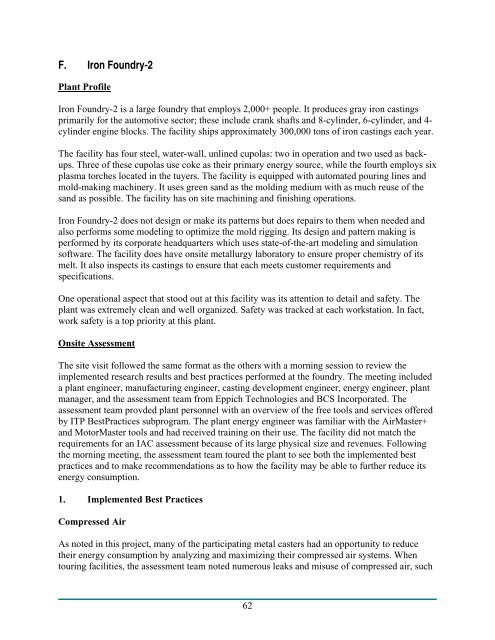Implementation of Metal Casting Best Practices - EERE - U.S. ...
Implementation of Metal Casting Best Practices - EERE - U.S. ...
Implementation of Metal Casting Best Practices - EERE - U.S. ...
You also want an ePaper? Increase the reach of your titles
YUMPU automatically turns print PDFs into web optimized ePapers that Google loves.
F. Iron Foundry-2<br />
Plant Pr<strong>of</strong>ile<br />
Iron Foundry-2 is a large foundry that employs 2,000+ people. It produces gray iron castings<br />
primarily for the automotive sector; these include crank shafts and 8-cylinder, 6-cylinder, and 4cylinder<br />
engine blocks. The facility ships approximately 300,000 tons <strong>of</strong> iron castings each year.<br />
The facility has four steel, water-wall, unlined cupolas: two in operation and two used as backups.<br />
Three <strong>of</strong> these cupolas use coke as their primary energy source, while the fourth employs six<br />
plasma torches located in the tuyers. The facility is equipped with automated pouring lines and<br />
mold-making machinery. It uses green sand as the molding medium with as much reuse <strong>of</strong> the<br />
sand as possible. The facility has on site machining and finishing operations.<br />
Iron Foundry-2 does not design or make its patterns but does repairs to them when needed and<br />
also performs some modeling to optimize the mold rigging. Its design and pattern making is<br />
performed by its corporate headquarters which uses state-<strong>of</strong>-the-art modeling and simulation<br />
s<strong>of</strong>tware. The facility does have onsite metallurgy laboratory to ensure proper chemistry <strong>of</strong> its<br />
melt. It also inspects its castings to ensure that each meets customer requirements and<br />
specifications.<br />
One operational aspect that stood out at this facility was its attention to detail and safety. The<br />
plant was extremely clean and well organized. Safety was tracked at each workstation. In fact,<br />
work safety is a top priority at this plant.<br />
Onsite Assessment<br />
The site visit followed the same format as the others with a morning session to review the<br />
implemented research results and best practices performed at the foundry. The meeting included<br />
a plant engineer, manufacturing engineer, casting development engineer, energy engineer, plant<br />
manager, and the assessment team from Eppich Technologies and BCS Incorporated. The<br />
assessment team provded plant personnel with an overview <strong>of</strong> the free tools and services <strong>of</strong>fered<br />
by ITP <strong>Best</strong><strong>Practices</strong> subprogram. The plant energy engineer was familiar with the AirMaster+<br />
and MotorMaster tools and had received training on their use. The facility did not match the<br />
requirements for an IAC assessment because <strong>of</strong> its large physical size and revenues. Following<br />
the morning meeting, the assessment team toured the plant to see both the implemented best<br />
practices and to make recommendations as to how the facility may be able to further reduce its<br />
energy consumption.<br />
1. Implemented <strong>Best</strong> <strong>Practices</strong><br />
Compressed Air<br />
As noted in this project, many <strong>of</strong> the participating metal casters had an opportunity to reduce<br />
their energy consumption by analyzing and maximizing their compressed air systems. When<br />
touring facilities, the assessment team noted numerous leaks and misuse <strong>of</strong> compressed air, such<br />
62

















